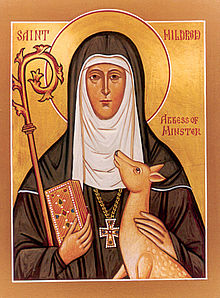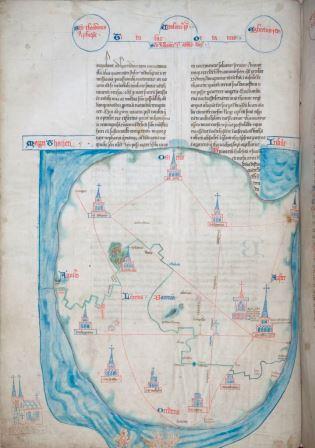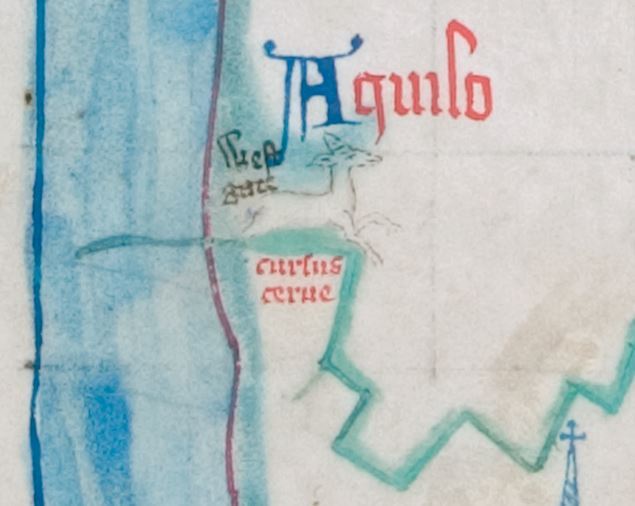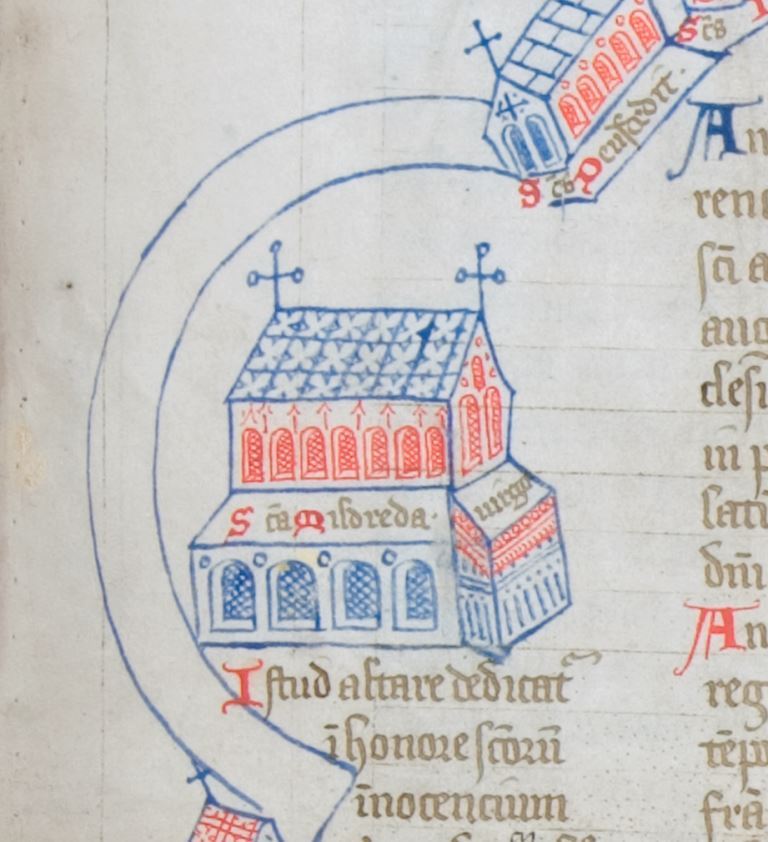Posted:
11 Aug 2017
One of the great treasures of the Old Library is an early fifteenth century manuscript, Historia Monasterii S. Augustini Cantauriensis, by Thomas of Elmham, a medieval monk and historian. Elmham’s history of St Augustine’s Abbey and its lands contains elaborate chronological tables and facsimiles of many lost Anglo-Saxon charters. Amongst these pages recording the deeds of clerics are two magnificent full page illustrations which reveal the presence of two high status women!
The women who were so important to the history of St Augustine’s Abbey were Domme Eafe and her daughter Mildrith. Domme Eafe had impeccable royal lineage – she was descended from King Æthelberht of Kent and was married to King Merewalh of Magonsaete (a sub-kingdom of Mercia). This remarkable queen founded the abbey of Minster-in-Thanet and all three of her daughters, Mildburh, Mildgytha and Mildrith, were saints.

Saint Mildrith (image from Wikipedia)
The most notable of the three was Saint Mildrith (c. 660-733). She features in the Kentish Royal Legend or “Mildrith legend” and Goscelin wrote a hagiography of her, the “Vita Mildrethae”, in the 11th century. As a royal woman Saint Mildrith received an education at the prestigious Merovingian royal abbey of Chelles, near Paris, which had a reputation for great learning. On her return to England she entered the abbey of Minster-in-Thanet. By 694 Saint Mildrith had risen to become the Abbess at Minster-in-Thanet and when she died in about 734 she was buried in the Abbey church of St Mary.

Isle of Thanet (Trinity Hall Cambridge MS.1)
This illustration (above) from MS.1 is a map of the Isle of Thanet. It features important landmarks, churches and abbeys, including that of Minster-in-Thanet. It also shows the course (marked as a green line) said to have been taken by a white hind belonging to Queen Domme Eafe, when it designated the land granted for the foundation of the abbey of Minster-in-Thanet.

“Cursus cerue”: the path taken by Domme Eafe’s white hind (detail from Trinity Hall Cambridge MS.1)
The other full page illustration in this manuscript shows the East end of the abbey church of St Augustine’s in Canterbury. It depicts the high altar surmounted by precious reliquaries and six holy books. The shrine of St Augustine is situated in pride of place behind the high altar at the East end.

Plan of the East end of St Augustine’s Abbey (Trinity Hall Cambridge MS.1)
But Saint Mildrith has a shrine there too! How did she come to be there? According to Julian Luxford, the nunnery of Minster-in-Thanet had fallen into disuse and in 1030 King Cnut granted his permission for the relics of Saint Mildrith to be moved from the abbey church of St Mary to the church of St Augustine’s Abbey in Canterbury “where she was venerated alongside the early archbishops”. Her importance is revealed by the magnificence of her shrine and its site just next to the chapel with the relics of St Augustine.

Saint Mildrith’s shrine in the abbey church of St Augustine’s Canterbury (Trinity Hall Cambridge MS.1)
This tale of two medieval royal women who feature in the illustrations of MS.1 is part of our series of posts looking at “Women in the special collections of Trinity Hall” in celebration of the THWomen40 anninversary.
Postcript:
St Augustine’s Abbey is managed by English Heritage and is open to the public. English Heritage has just published a new guidebook by Julian Luxford which includes a full colour reproduction of the illustraion in our manuscript of the East end of the Abbey church.
References:
Description by Montague Rhodes James of Historia Monasterii S. Augustini Cantauriensis (Trinity Hall Cambridge MS.1)
“St Augustine’s Abbey” by Julian Luxford (English Heritage Guidebooks, 2017) ISBN 9781910907160
St Augustine’s Abbey (English Heritage) http://www.english-heritage.org.uk/visit/places/st-augustines-abbey/
